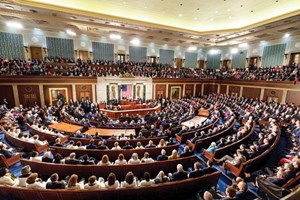In the Biden/Harris Presidency, any fracing ban is least of the industry’s worries
After a close election and a wild aftermath, Democrats Joe Biden and Kamala Harris will occupy the White House for the next four years. As such, they will set the Executive Branch agenda for national energy policy, at least through 2024. While the various and constantly evolving Biden/Harris promises to ban hydraulic fracturing—at one level or another—dominated the narrative during the general election campaign, the approach they will choose to take on a range of oil and gas issues, now that they are in a position of power, will come into sharp relief.

With Donald Trump, what you saw him promise during the 2016 election campaign was what you got once he assumed office: This country has never experienced any President who was more singularly focused on following through on each and every commitment that he had made while running for the office. With Biden and Harris, it remains impossible to really know what their promises even amounted to, related to oil and gas and energy in general, other than to work to undo all the things that the Trump Administration implemented during the previous four years.
That one thing is really what everyone in the oil and gas industry should remember about this incoming Democratic administration: It will be singularly focused on taking away every policy-related gain that was made from 2017 through 2020, Fig. 1. And the new administration will have a wealth of tools and strategies at its disposal to achieve that goal.
THE COMING EXECUTIVE ORDERS
The first wave of negative impacts for the oil and gas business will come in the form of executive orders. Like the Obama/Biden presidency before him, a great deal of President Trump’s energy-related policy has been enacted via executive orders. The obvious vulnerability of any executive order is that it usually can be reversed easily by a successor in office.
Thus, the most immediate impacts of a Biden/Harris presidency will come in the form of efforts to increase regulation on the energy industry via the reversal of various Trump executive actions. Biden and Harris repeatedly promised to take these actions throughout their campaign, in order to placate and curry favor with the Democratic Party’s far-left activist base. So, we should expect a quick follow-through on what amounts to low-hanging fruit.
Those likely executive order reversals include:
- Re-entry of the United States into the Paris Climate Accords. President Trump’s decision to rescind U.S. participation in this counterproductive international agreement was a highly-emotional point of controversy with left-wing environmentalists. A Biden order mandating recommitment could well become his very first order of business on Jan. 20, 2021.
- Re-entry of the United States into the Obama-era Iran deal. Another point of huge controversy was President Trump’s decision to cancel U.S. participation in this Obama-era executive agreement. A recommitment by the U.S. to the terms of this deal would free up Iran to dramatically increase its crude oil exports, likely resulting in a negative impact on crude prices.
- Recission of President Trump’s order to end the Council on Environmental Quality’s guidance that all federal permitting decisions and environmental reviews must consider climate change impacts. This guidance was used religiously by the Obama/Biden EPA and Department of Interior to dramatically inhibit permitting of oil and gas operations and facilities for eight years. It was one of their most effective tools. There is little doubt that the Biden/Harris Administration will adopt the same tactic.
- Recission of the Trump order to disband the Interagency Working Group on Social Cost of Greenhouse Gases. This was another tool used by the Obama/Biden bureaucracy to retard energy development on federal lands from 2009 through 2016.
- Recission of Trump’s various orders designed to eliminate delays in federal permitting processes. President Trump issued several orders throughout his term in office, designed to streamline various federal permitting and compliance processes, all working toward the goal of enhancing domestic energy production. The Biden/Harris Administration will have no such goal, and, in fact, will likely work very hard to achieve the exact opposite result. All of these Trump orders are likely to fall by the wayside very quickly after Jan. 20.
- Hydraulic fracturing. At the very least, it should be assumed that the Biden/Harris Administration will follow through on Biden’s promises to ban hydraulic fracturing on federal lands and waters, which represent a very sizable percentage of overall U.S. oil and gas production. This is the least that should be expected, and it can be accomplished by an order from either a President Biden or from his future Secretary of the Interior. We also should expect Interior to follow up and attempt to frame any order in the form of regulations, to make it more of a permanent change;
- But that’s not all. It is also important to remember that Sen. Kamala Harris repeatedly promised to eliminate hydraulic fracturing entirely in the U.S. during her own presidential effort in 2019 and early 2020, and never really backed off of that promise during the general election campaign as Biden’s running mate. On the few occasions when she was asked about it by a timid and fawning press corps, Harris was always very careful to say that “Joe Biden will not ban fracing,” and no more than that. Given that Biden would be 78 years old on Inauguration Day, threats to the continuation of legal fracing in the U.S. could rise considerably, if he were unable to finish his term.
A FLOOD OF NEW REGULATIONS TO COME
Then there would be the Biden/Harris regulatory agenda. A Biden/Harris Administration is very likely to pursue a regulatory agenda that will look a lot like the aggressive agenda taken up during the second term of the Obama/Biden presidency. As we saw from 2013 through 2016, the executive has many regulatory tracks to pursue to limit the oil and gas industry, including not just the Department of Interior, but also the Environmental Protection Agency and OSHA, all of which can significantly raise costs in the oil and gas sector and slow the ability to complete major projects.
Remember that much of the Trump energy agenda focused on removing onerous, unnecessary regulations that the Obama/Biden Administration had sought or implemented. These included major Obama/Biden-era efforts such as:
- The incredibly expansive Waters of the United States effort by the EPA. As drafted and almost finalized by Obama/Biden, this rule would have seen EPA bureaucrats overseeing vast swaths of the U.S. economy. It was discarded by the Trump EPA and replaced with a far less expansive rule. Expect a new effort to expand EPA authority in this area in the coming four years.
- The BLM rule on flaring. This was another effort almost finalized by the Obama/Biden people. Expect it, or something more onerous, to be brought back up in 2021.
- BLM/EPA regulations on methane emissions. Despite industry progress to voluntarily curb its own emissions in the 21st century, the Obama/Biden EPA had a laser focus on trying to implement draconian, command-and-control regulations in this area during its final two years. Expect this focus to be renewed, starting on Jan. 20.
- New BLM regulations on hydraulic fracturing. Any Biden/Harris executive order banning fracing on federal lands will need to be backed up with regulations or face recission by the next Republican President in a few years.
PIPELINES, PORTS AND EXPORTS
The Federal Energy Regulatory Commission (FERC) also has the ability to slow the midstream sector considerably by slowing and obstructing the development and completion of major new interstate pipeline projects. Democratic governors like Andrew Cuomo (New York) have had great success in obstructing new pipeline projects from crossing through their states; obviously, a reconstituted FERC would possess far greater power to obstruct the installation of critical new infrastructure. Over the past year, the midstream industry has also seen Obama-appointed federal judges issue a series of unprecedented decisions, designed to halt major pipeline infrastructure projects like the Dakota Access Pipeline and the northern leg of the Keystone XL.

Finally, remember the key roles that various federal agencies play in permitting and authorization of major industry-related facilities, such as LNG export facilities, refineries and expansions and improvements of shipping ports. Agencies involved include the EPA, the Department of Commerce, the Department of the Interior, the U.S. Army Corps of Engineers, to name a few.
The two senate run-off elections in Georgia become a key factor in this area. Should the Democrats manage to win both of those seats, they would then control razor-thin majorities in both houses of Congress. That level of control would enable them to hold up needed deepening and widening of various U.S. ports, simply by holding up funding for the Corps of Engineers, which manages all such projects across the nation, Fig. 2.
CONCLUSION
So, while a ban on fracing consumed the headlines during the general election campaign, a new administration has many avenues available to slow a domestic oil and gas business that is already struggling with impacts of the Covid-19 pandemic. Industry veterans will remember the frenetic pace of new regulatory efforts mounted by the Obama/Biden Administration during its final two years. It is reasonable to expect a Biden/Harris presidency to replicate that pace. And if the Democrats are able to gain control of the Senate, that regulatory agenda could turn out to be the least of the industry’s worries.
- Coiled tubing drilling’s role in the energy transition (March 2024)
- Shale technology: Bayesian variable pressure decline-curve analysis for shale gas wells (March 2024)
- Digital tool kit enhances real-time decision-making to improve drilling efficiency and performance (February 2024)
- E&P outside the U.S. maintains a disciplined pace (February 2024)
- Prices and governmental policies combine to stymie Canadian upstream growth (February 2024)
- U.S. operators reduce activity as crude prices plunge (February 2024)


